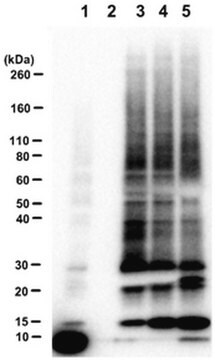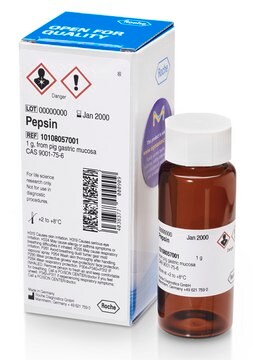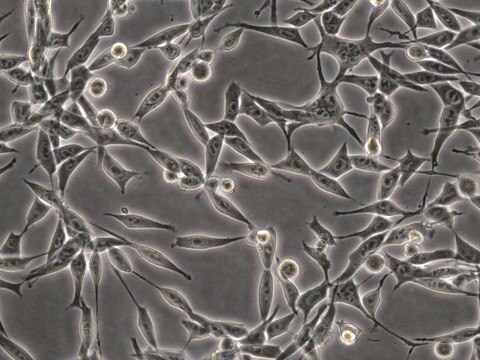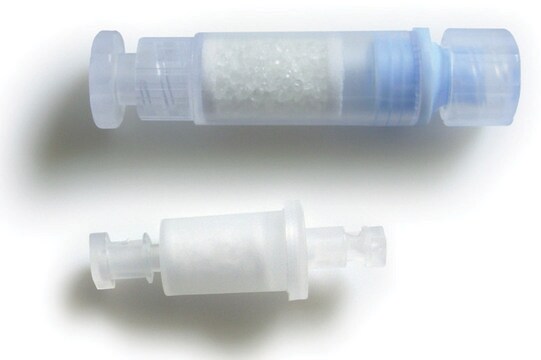662200
Ubiquitinated Protein Enrichment Kit
Faça loginpara ver os preços organizacionais e de contrato
About This Item
Código UNSPSC:
41116133
Produtos recomendados
uso
kit sufficient for 12.5-25 mg process (lysate)
Nível de qualidade
fabricante/nome comercial
Calbiochem®
condição de armazenamento
do not freeze
temperatura de armazenamento
2-8°C
Descrição geral
A rapid method for isolating ubiquitinated proteins using affinity beads comprised of a GST-fusion protein containing an ubiquitin-associated sequence bound to glutathione-agarose. Useful for the enrichment of polyubiquitinated proteins from cell and tissue lysates of a broad range of species including canine, human, mouse, and yeast. The ubiquitinated proteins can be identified by loading the beads directly onto SDS-PAGE and then immunoblotting with the antibody of choice or Anti-Ubiquitin (Cat. No. 662099). Alternatively, it is possible that the beads can be treated with Isopeptidase T (Cat. No. 419700) to release the proteins from the ubiquitin chains.
A vast majority of short-lived proteins are degraded by the ubiquitin-proteasome pathway. A protein marked for degradation is covalently attached to multiple molecules of ubiquitin, a highly conserved 76-amino acid (8.6 kDa) protein, by a multi-enzymatic system consisting of Ubiquitin-activating (E1), Ubiquitin-conjugating (E2), and the Ubiquitin-ligating (E3) enzymes. The E1 activates a Ubiquitin monomer at its C-terminal cysteine residue to a high-energy thiolester bond which is then transferred to a reactive cysteine residue of the E2 enzyme. The final transfer of ubiquitin to e-amino group of a reactive lysine residue of substrate proteins is brought about by the E3 enzyme. Ubiquitinated protein is then escorted to the 26S proteasome where it undergoes final degradation and the ubiquitin is released and recycled. A family of proteins including Rad23, contain two ubiquitin-associated domains that bind ubiquitinated cellular proteins and translocate them to the proteasome. Ubiquitinated proteins can be enriched using affinity beads comprised of a GST-fusion protein containing this ubiquitin-associated sequence conjugated to glutathione-agarose.
Componentes
Polyubiquitin Affinity Beads, Control Glutathione-Agarose Beads, Control Lysate, and a user protocol.
Advertência
Toxicity: Multiple Toxicity Values, refer to MSDS (O)
Armazenamento e estabilidade
Upon arrival store entire contents of the kit at 4°C.
Outras notas
Chen, L. and Madura, K. 2002. Mol. Cell Biol. 22, 4902.
Chen, L., et al. 2001. EMBO Rep.2, 933.
Chen, L., et al. 2001. EMBO Rep.2, 933.
Informações legais
Sold under license of PCT Application wo 03/049,602.
CALBIOCHEM is a registered trademark of Merck KGaA, Darmstadt, Germany
Palavra indicadora
Danger
Frases de perigo
Declarações de precaução
Classificações de perigo
Acute Tox. 4 Dermal - Aquatic Chronic 3 - Eye Dam. 1 - Repr. 2 - Skin Sens. 1
Código de classe de armazenamento
10 - Combustible liquids
Certificados de análise (COA)
Busque Certificados de análise (COA) digitando o Número do Lote do produto. Os números de lote e remessa podem ser encontrados no rótulo de um produto após a palavra “Lot” ou “Batch”.
Já possui este produto?
Encontre a documentação dos produtos que você adquiriu recentemente na biblioteca de documentos.
J Zhu et al.
Oncogene, 33(34), 4340-4351 (2014-01-21)
Estrogen receptor α (ERα) is initially expressed in the majority of breast cancers and promotes estrogen-dependent cancer progression by regulating the transcription of genes linked to cell proliferation. ERα status is of clinical importance, as ERα-positive breast cancers can be
Jian Chen et al.
The American journal of pathology, 175(1), 400-411 (2009-06-17)
Tumor hypoxia directly promotes genomic instability and facilitates cell survival, resulting in tumors with a more aggressive phenotype. The proto-oncogene pim-1 regulates apoptosis and the cell cycle by phosphorylating target proteins. Overexpression of Pim-1 can cause genomic instability and contribute
Christian Ehlting et al.
Scientific reports, 9(1), 11021-11021 (2019-08-01)
The p38MAPK downstream targets MAPKAP kinases (MK) 2 and 3 are critical for the regulation of the macrophage response to LPS. The extents to which these two kinases act cooperatively and distinctly in regulating LPS-induced inflammatory cytokine expression are still
Roi Cal et al.
Arteriosclerosis, thrombosis, and vascular biology, 33(2), 369-377 (2012-12-18)
Low density lipoprotein retention and aggregation in the arterial intima are key processes in atherogenesis. Aggregated LDL (agLDL) is taken up through low-density lipoprotein receptor-related protein 1 (LRP1) by human vascular smooth muscle cells (VSMC). AgLDL increases LRP1 expression, at
Nossa equipe de cientistas tem experiência em todas as áreas de pesquisa, incluindo Life Sciences, ciência de materiais, síntese química, cromatografia, química analítica e muitas outras.
Entre em contato com a assistência técnica









